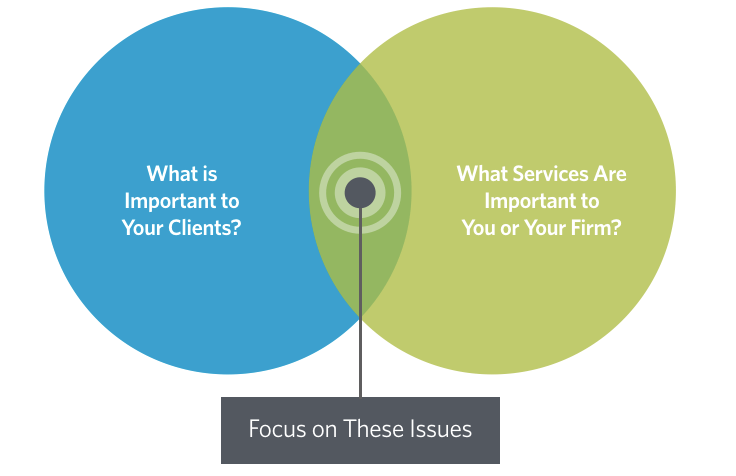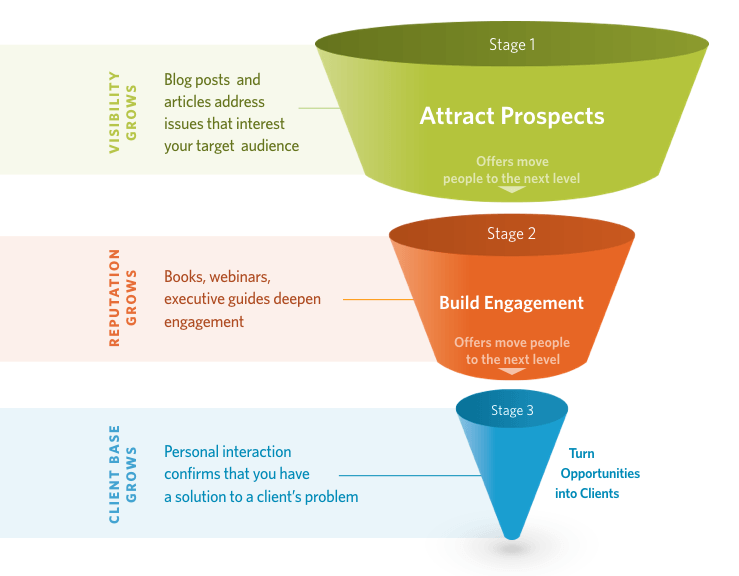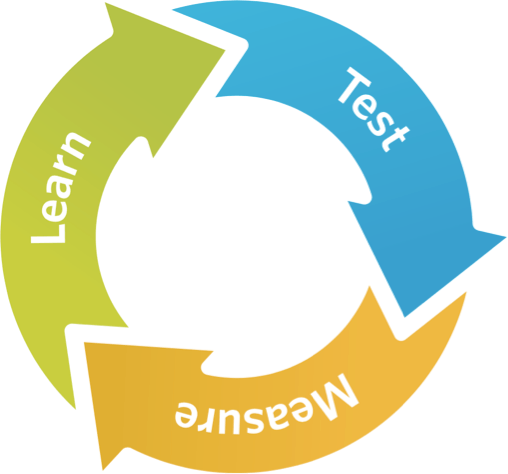Rebecca Lieb, in her book Content: The Atomic Particle of Marketing, describes content as the single most important element of any marketing campaign. At Hinge, we talk about content as not only being important – but as having changed the way professional services are both bought and sold.
While the B2B community still thrives on word-of-mouth referrals for winning new business, prospective clients – even in the most traditional industries – have learned to turn to digital channels first when they’re looking for someone to solve their problem. Digital channels give open, unobstructed access to what buyers of B2B services prioritize most when judging your fit for their needs – your expertise. This is echoed in our own research. In Hinge Research Institute’s 2023 survey of the marketing practices and priorities of high-growth professional services firms, we found that high-growth firms prioritize making their expertise more visible, and they do it through valuable, educational content.
Why the uber focus on content? Isn’t there enough noise out there, where every firm has a blog and posts on social media? While the digital universe allows us to fake many things, you can’t easily fake expertise. You can certainly try. Just because you have a blog however doesn’t mean your blog is informative. Herein lies the primary set of reasons for why B2B content marketing strategies can fail.
What is a B2B Content Marketing Strategy?
Before I get to those reasons, let me put some definition around what I’m talking about. A B2B content marketing strategy is an online strategy that elevates thought leadership – the written manifestation of a firm’s expertise – through the routine publication of free, valuable, educational content. This type of educational content is then used to attract new leads, nurture existing leads, and build preference for the firm.
However, content marketing is only as valuable as it is on par with topics that are relevant to a firm’s target clients. When a firm develops content that resonates with what audiences are grappling with most – content that is tightly tied to the challenge that woke the target decision maker up at 4 in the morning, it accomplishes three things:
- Demonstrates a deep understanding of issues its prospects care about
- Engages its audience
- Builds trust
The more often a firm produces relevant content, the more engagement it creates, and the more trusted it becomes. In many cases, leads that are nurtured through content marketing become “converts” to a particular firm’s approach or way of thinking. Sometimes they will even hire a firm they have been following without soliciting competitive bids.
Bottom line: educational content is the new currency of the professional services marketplace. Content marketing is the strategy that turns that content into profits.
When content marketing fails
If content marketing is associated with all things good: profitable, results-oriented marketing that carries a relatively lower level of effort than some traditional marketing, client loyalty and so on, why aren’t more firms on board? Because it’s also associated with a high rate of failure – which in turn yields a high dose of skepticism about whether content marketing is a worthy investment.
With that, I’d like to point to 8 primary reasons that B2B content marketing strategies fail.
1. CONTENT THAT ISN’T RELEVANT TO THE TARGET AUDIENCE
The most foundational reason that content fails is when it’s not important or relevant to the target audience. Content won’t perform in the way I described above when it’s written only in the context of what you know and what’s important to you. It’s only when you produce content that intersects what you know with your clients’ key priorities that it can be truly relevant.
A second guiding principle around producing relevant content is discipline. Writing about everything you know won’t cut it either. Rather, think from your audience’s perspective. They’re trying to figure out what you’re an expert in. Just like listing 20 services and even more sub-services in the navigation of your website produces a suboptimal and confusing user experience, when you produce thought leadership about everything under the sun that relates to those multiple services, prospective clients are left wondering, “what does this firm really do?”
Instead, keep a visual in your head much like the figure below. Think about the couple of services that are really critical to your firm’s growth, intersected with the challenges and problems that keep your prospective clients up at night. This exercise will help you uncover some finite set of issues around which you should then produce your thought leadership.

Here are several criteria to consider when choosing your topics:
- Relevance to your customer and your services
- Aim for issues where there is lack of consensus on the solution
- Write on topics that are not likely to go away in the short-term
- Avoid issues that are already “owned” by a competing firm
2. CONTENT THAT IS MORE PROMOTIONAL THAN EDUCATIONAL IN NATURE
How many times have you come across a firm’s blog, only to find it full of posts about the new office move, latest hires, or direct plugs for their services? To be sure, there is a place and time for all of that promotional content. But buyers of professional services don’t want to be sold or marketed to until they’re ready – so if that’s all they have access to as they come across your firm for the first time, you’re not likely to hear from them again. On the other hand, if in that first impression you wow them with expertise that potentially solves their problems, the experience is game changing.
Absent of educational, relevant thought leadership, a content marketing strategy really isn’t a strategy at all – it’s just a big promotional brochure. By creating a content strategy focused on sharing expertise (as opposed to selling product), you’re encouraging prospective clients to enter into your sales and BD funnel where you can continue to share that expertise and ultimately build enough trust that you turn them into a client.
3. CONTENT THAT DOESN’T TAKE INTO ACCOUNT HOW YOUR CUSTOMER WANTS TO LEARN.
Speaking of a funnel, winning new business is about creating a journey for prospective clients to follow as they learn about your organization. The challenge to marketers is to know where prospective clients are on their journey. There is no one point of entry, nor is there a singular journey that fits all of your prospective clients.
This is why content strategies done right are so valuable – they are the atomic particles of all your digital marketing efforts. Take a look at the funnel below. Educational thought leadership flows in, across, and throughout the entire sales funnel. It’s the shiny rock that attracts the attention of those who’ve never heard of you, and the glue that keeps them along for the ride, convincing them you’re the solution to their problems.

A key component to consider in your content marketing strategy is research. It is well known that research can help marketing, business development, and senior management teams develop more informed plans and strategies, it can also be used as the foundation for many premium pieces of content to generate more visibility, trust, engagement, and best of all, leads. Research studies, either custom, commissioned studies or data that has been licensed from other groups, can be used throughout your sales and marketing funnel. One single research study has the capability to be broken down into countless pieces and can be shared alongside nearly any other message you broadcast within your strategy.
4. CONTENT THAT EXISTS ONLY ON YOUR WEBSITE.
For an effective content marketing strategy, you need to do more than just post your content on your website. At minimum, social media channels where your audience is networking should be a home for your articles and blogs. This is important because, according to our research, your buyers check you out on social media as they’re learning about you as a fit for their organization. The more you promote your content via social media, the more prospective clients and referral sources will see it — and over time, come to recognize your organization for its quality content and expertise.
You should also consider pursuing publishing opportunities in digital publications your audiences read – or where your competitors are placed. Having someone else stand behind your expertise goes a long way in convincing your audience that you are worth their time – not to mention the excellent contribution backlinks from published articles can make to your website’s domain authority.
5. CONTENT THAT CUSTOMERS CAN’T EASILY FIND.
Even the most thoughtfully written and produced content will fail if prospective clients never find it. Therefore, before you produce the actual content, do some research about which keyword phrases mirror your audience’s search activity. By using those keywords in your content’s headlines and body copy, the content will appear higher in their searches.
Remember that when deciding on which keyword phrases to use, you should find ones that are relevant to the topic, and that your organization can rank for. (If you’re new to the process and strategy of selecting keyword phrases, you may want to check out this article.)
6. CONTENT THAT IS RANDOM OR AD HOC.
One of the biggest transgressors of a B2B content marketing strategy is the randomness with which content gets written. To borrow from the first reason I stated above, you should avoid filling your content funnel with all that you know or even all that you love. Even if Tom is super passionate about topic X, Tom shouldn’t spend company time writing about topic X unless it fits in strategically in the intersection of what your audience cares about and your organization’s growth priorities.
One very practical way to maintain discipline around your strategy is to build an editorial or content marketing calendar. Sounds simple, but not everyone takes this step. Organize thought leadership titles around that finite number of issues you should be known for (again, think about the Venn diagram above), and match those well-researched keywords that you want to – and can be – found for. By creating and adhering to a content calendar, you’ll help your content writers focus their energies strategically.
7. CONTENT THAT’S INCONSISTENT.
Consistency is vital to credibility, so be sure to develop content standards and styles that you can live with, and then enforce them as new content is created, no matter who in your organization creates it. The content calendar I just mentioned is a big part of helping your firm avoid the “set it and forget it” syndrome.
We commonly get asked the question around how much content needs to be produced. The right rhythm and cadence for your firm will be so dependent on your resources as well as how aggressively you need to track to greater growth and visibility. If you are just starting out, twice a month isn’t awful. On the other hand, if you find the competitive landscape to be formidable, or you are desperately trying to unveil your firm from the cloak of invisibility, you’ll need to produce content more frequently. There is no magic number. The final point I make below on consistently measuring and tracking will help you understand how your audience is receiving your content, which in turn will help you determine the right cadence.
8. CONTENT THAT’S NOT BEING MEASURED.
Finally, content marketing strategies are vulnerable to failure when firms have no measurement of their performance. The figure below illustrates the virtuous cycle of content marketing, in which you continually test your content, measure how it’s performing, learn from what works, and then factor those lessons into the next round of content.

A continuous improvement model for content creation
A common challenge is understanding which metrics to track. We recommend that you monitor several types of metrics.
- Visibility metrics — These will help you gauge how visible you are to your target audience. Common visibility metrics include total website traffic (web traffic rises with increased visibility), social media traffic and attendance at events.
- Expertise metrics — These tell you if your audience is exposed to your thought leadership content (i.e., are you successfully demonstrating your expertise?). Common expertise metrics include blog views, downloads of your premium content, guest posts, webinar attendees and attendance at speaking events.
- Impact metrics— These can include raw (not yet qualified) leads or inquiries, “sales-ready” opportunities and actual proposals submitted. Your firm may describe these stages differently. It does not matter how you define your lead stages as long as you are consistent and capture the full new-business cycle. You’ll also want to track wins, losses, and even higher level metrics such as monthly revenue so that you keep a pulse on how your content strategy is (or isn’t) contributing to the bottom line.
Download the Content Marketing Guide for Professional Services Firms
What type of content should be in my B2B content marketing strategy?
We find the most effective approach to content marketing is to provide a wealth of freely available material—no commitment, no registration, no cost. Most of this material will be short-format pieces, such as blog posts and articles.
So how do you get started? What kinds of content can you create?
For most firms, blogging is the easiest and most productive way to get started. Because blog posts can be any length and less polished than, say, a magazine article, they can be produced and published quickly. If commenting is enabled, blog posts also provide a great way to interact with your audience.
But blogs only scratch the surface. Here are some other important content marketing vehicles to consider as you retool your marketing plan:
- Webinars. By themselves, webinars offer a good way to demonstrate your firm’s expertise, educate your audience and cultivate interested leads. If you record your webinars, they can be added to your library of content so that web visitors can view them at any time.
- Articles and white papers. Perhaps the most familiar form of thought leadership, these medium-length pieces are still valuable. Unfortunately, they have a reputation for being dry. So do your best to make them an easy read.
- Social media. Social media, especially LinkedIn and Twitter, can be important channels to speak directly to your audience, answer questions and promote your educational material.
- E-newsletters. Many people prefer to receive educational content by email inbox. In return, you get their email address and the ability to expose them to more of your expert material.
- Ebooks. For the ultimate credibility boost, publish an in-depth study of a topic. Usually, you will want to put something this valuable behind a short registration form.
- Kits and guides. These medium-length pieces make terrific offers on your website, in pay-per-click ads and in email marketing campaigns. Put them behind a registration form so that you can collect leads.
There are many other formats you can use to package information, but these are some of the most popular and most effective.
At Hinge, we freely distribute our research studies, which is arguably the most valuable content we produce. We do so to generate valuable buzz and inbound links. We recommend such longer pieces require registration. That way the reader trades some basic contact information (sometimes little more than their name and email address) for the piece. The reader gets valuable information and you build your list of leads. A fair trade.
Conclusion
Every client, prospective client, and referral source has specific topics they’re interested in and want to learn more about. As they search for answers, they are also looking to find trusted, accessible sources of that information. Creating relevant content addresses this need, and can also help clients vet you as a potential vendor. Still questioning the role of valuable content? Our research shows that even with a referral, 23.5% of prospective clients rule out firms simply because of poor quality content. And, by avoiding these common pitfalls as you’re developing content marketing strategy, your organization can improve how it meets your prospective clients’ need for information on essential topics. More importantly, you will also convey a level of expertise and accessibility that will make them want to do business with you in the future. Best of luck on your journey!
Related: Three Return on Marketing Investment Strategies Used by High-Growth Professional Services Firms


